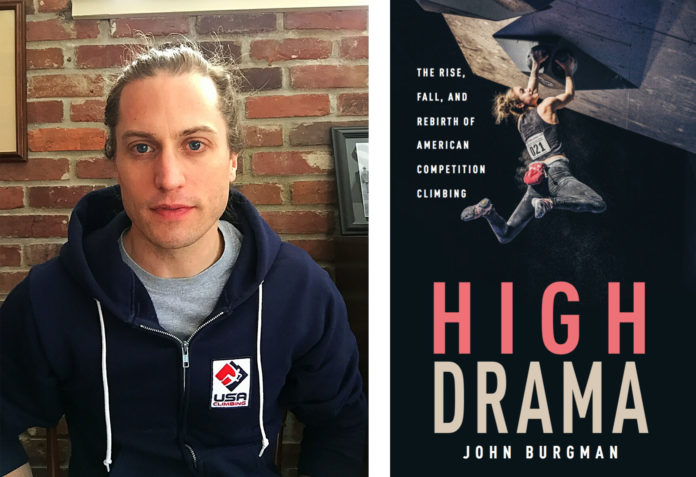Behind the Desk is a series that highlights people who work in the climbing industry. In this segment, we veer from the norm and “interview the interviewer,” CBJ’s own Senior Editor John Burgman. John is the pre-eminent comp climbing journalist in the United States. He has authored three books, the latest being High Drama: the rise, fall and rebirth of American competition climbing. John has been especially busy during the build-up to the Olympics, reporting extensively for Climbing and appearing in industry media like Plastic Weekly and non-endemic outlets like NPR. In between covering Tokyo and interviewing climbing’s greats, John sits down with us to chat about his career thus far: breaking into the field of climbing journalism, living in South Korea and researching North Korean defection, working on the High Drama project, and the future of comp climbing.

JR: So let’s start at the beginning: What were your pre-climbing days like, and how did you get into climbing, journalism, climbing journalism in particular, and writing for CBJ?
JB: I’m from the Midwest like you, so I didn’t grow up with access to the mountains or anything like that. I gave climbing a try in college because there was a fairly state-of-the-art climbing wall at the university’s rec center. I fell in love with it right away. It’s not an exaggeration to say it was definitely a life-changing moment, obviously, since it shaped the course of my life and career in many ways.
But at that time, I had no idea what I wanted to do for a career, I just liked writing [laughs]. So, I got some jobs―paid and unpaid―working for various magazines and literary journals. It was everything from editing articles to just reading submissions―the slush pile, as they call it [laughs]. Eventually I got a job at a magazine in New York City as a staff editor. That was the beginning of my “journalism career,” for lack of a better phrase, but I didn’t think of it in that way at the time. I was just happy to have a job that wasn’t making minimum wage at coffee shops and bookstores―which was what I had been doing up until that point.
Several years later, I ended up getting a Fulbright research grant, which allowed me to move to Asia and broaden my interests and journalism opportunities. It was actually while I was living in Asia that I started reading CBJ. A year or so after Mike Helt started CBJ [in 2013], I cold-emailed Mike and said, “I love this. I’m a dedicated reader and not a gym owner, but I like the behind-the-scenes stories you tell about the industry. I’ve done some writing and I would love to write for you.” And he was kind enough to reply and asked me to pitch him some ideas. That got the gears churning and eventually I also started writing World Cup recaps for Climbing magazine.
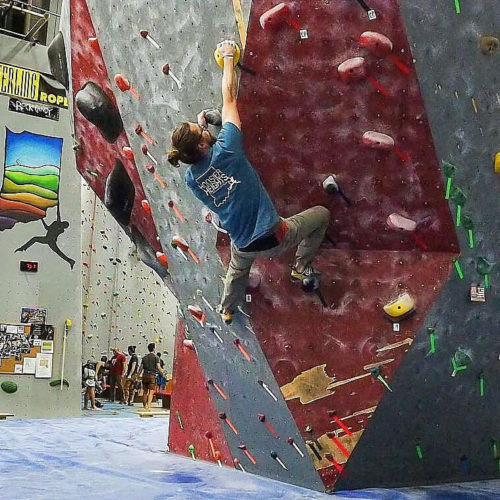
I want to ask about your time living in Asia. You talk about some of your experiences in South Korea in your book Island Solitaire. What were some highlights of your time there?
I look back so fondly on all my time in South Korea. It was such an enriching experience, it’s hard to distill the whole thing into favorite memories. I lived in Seoul for a year, and then I moved to Jeju Island—which is what Island Solitaire is about. But during my time in Seoul, I was researching North Korean defection through that Fulbright research grant. That whole experience of talking and getting to know some North Korean defectors is still vivid in my memory.
People who defect from North Korea, if they escape North Korea and end up in South Korea―which is not everyone, as many people end up settling elsewhere in Asia―then they have to spend time in programs, first held at a live-in facility called a hanawon, and then optionally at a “hana center.” There are various goals at the hana centers, but a main aim is to support the North Korean defectors’ transition to a whole new way of life—a life in South Korea. In North Korea, things like education and finances are totally different than in South Korea, so the programs focus on teaching people a new way of life, teaching people how to manage their finances in South Korea, how to get jobs, that sort of thing.
So, like I said, my research grant consisted of interviewing people who had defected from North Korea―primarily teenagers―who were either living in or had recently exited these facilities. I spoke Korean conversationally, but I would usually do the interviews with a translator, especially because there are different dialectical differences between North Korean and South Korean language. I wanted to publish a book from the interviews, but that didn’t end up happening.
Beyond compiling the research into a book, what was the goal behind interviewing the people who had defected from North Korea?
There were a few goals, but one of them was just uplifting their stories. You know, journalists are often looking for spectacular or heroic narratives, but what I had found was that every single person who made that journey from North Korea was heroic in certain ways. On one level, just their adjusting to South Korean society is a monumental achievement. There are so many challenges along the way, not only the geographic escape [from North Korea] itself, but the economic challenges that come with it. And anytime there’s poverty there are also potential related or ancillary barriers to overcome like gambling and substance abuse. There were just so many stories…
For example, one person who I had interviewed, she was 18 and had escaped from North Korea by herself. She had managed to come through all that and was now in a university in South Korea, pursuing a career. How is that not a story that the world should know about, if she wants to tell it? In some cases, people escaping from North Korea would be shot at by guards. I remember interviewing one person who pulled up her pant leg and showed me a scar on her ankle. She said, “This is where the bullet grazed me.” Even just talking now, you can see why these stories need to be heard. Fleeing, searching for and hopefully finding a better life…these are stories of the human spirit and perseverance. When you hear stories such as those, you realize this is the goal. Just hearing the story is the goal of the journalism.
Would you ever work in that field again in the future?
Yeah, it’s still something that I follow closely to this day, everything happening with North Korea and defection. When I was living in South Korea, I even thought about settling there permanently and getting a job at a hana center or a nonprofit in Seoul that supports people who are defecting from North Korea. It’s definitely something I’m still interested in—and still interested in writing about.
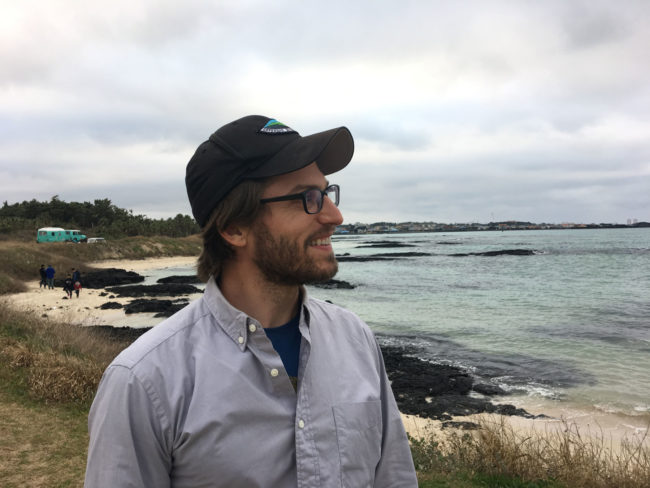
Moving on to your most recent book, High Drama, I love Kevin Corrigan’s quote on the back cover about how you “[unearth] the human stories behind the sport that otherwise may have been lost to time…” What were some of the highs and lows of working on this project?
I love that quote from Kevin too because that was my exact motivation for writing the book. I wanted to read about this history. I was starting to cover the competition climbing scene more, and as a journalist you have an obligation to know the history of whatever your subject is. So, I started looking for some background, and the first thing I did was go to Amazon and type in something like “competition climbing history” in the search bar—and there really weren’t any relevant results. I’m sure you’ve heard the phrase “write the book that you want to read,” and I literally wanted to read a book on American comp climbing history…yet it didn’t exist. So, I decided to start doing the research and write it myself.
The timing with the Olympics was definitely a high. It wasn’t at all something I’d planned around when the book was in its inception stage. But right when I started to get serious about the research and after doing a bit of the initial outline, it was announced that climbing was going to be in the Olympics. That created a nice, rough framework for the book. The Olympics were going to be part of the book anyways, because there has always been this Olympic buzz about climbing being included in the Games. And when that actually came to pass, that in a sense was the climax of the book: finally having competition climbing designated as an Olympic sport and having American climbers qualify for Tokyo. So that was a serendipitous, happy accident so to speak.
I don’t know if any lows stick out. The tricky thing with writing a book is that the history is so extensive and it is still ongoing. The book could have been twice as long, because there’s so much else that I could have included. But you have to make cuts, for length, which was too bad.
In writing the book, did you notice major themes from the early days which are still going on today? The labor issues, for instance, stood out to me.
That was something that I noticed too. When you talk to people about the ‘90s and they say, “Yeah, I worked at a gym in the ‘90s…didn’t get paid much and it was really hard work,” that quote could just as easily come from someone in 2021. You and I both worked at gyms, and we know that a lot of people working at gyms do it more for the love of climbing than the pay. And I think we’d all like to see more money able to be paid to people who work at gyms―especially routesetters, who work so darn hard and put their bodies through a lot of toil. Routes are the core product of a gym, and setters should be paid like they are providing the core product of the gym. But I do want to acknowledge the changes that have been made to pay people more livable wages; hopefully things keep moving in that direction.
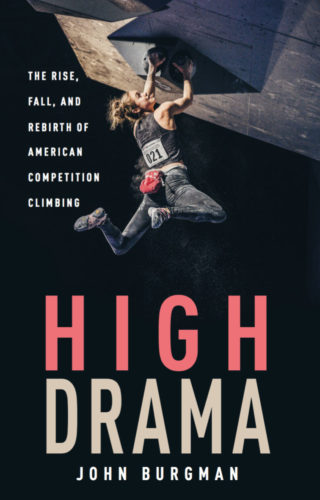
You must have spoken with so many people when writing High Drama, and throughout your career. What were some of your most memorable interviews, during this project or other?
I gotta say, it was cool interviewing [CBJ publisher] Scott Rennak, which sounds like we’re just scratching each other’s back [laughs]. But I interviewed him before he was the publisher of CBJ, and I just knew of him because of the American Bouldering Series (ABS). In my mind, ABS is this legendary entity, because that was where my fandom for competition climbing really began. When I first started climbing in college, I’d read Climbing and Urban Climber magazine―which doesn’t even exist anymore―and I’d flip to the back and look for ABS results. Then to actually be able to interview the person who created that competition series…it was just surreal. And the fact that Scott ended up giving me an hour and a half of his time, that meant a lot to me. Anytime someone gives you so much time for an interview, it’s almost like they’re telling you without telling you that they think your research is worthy. It’s a compliment of the research you’re doing and the book you’re trying to write. So, Scott giving me that blessing through the time he gave, that just meant the world to me.
Saving the easy question for last…What is the future of comp climbing and climbing journalism?
Well, my personal goal for the future is to make competition climbing the biggest sport in the world. People can think that’s ridiculous, fine, but that’s still my goal―ridiculous or not. So I hope that competition climbing continues to get bigger, and hopefully the Olympics helps. I hope there’s more prize money, so that climbers can focus on the competition scene and not feel like they need to do other activities alongside that just to get by.
I would also like to see more media outlets and more media members being willing and able to focus exclusively on the competition climbing scene. It’s tricky because I think there’s the chicken or the egg effect here. A lot of media may be reluctant to start a platform like that because they believe it’s not where climbing’s biggest fanbase is. I understand that line of thinking, but I have always thought that if the media seem stoked about something then they can play a role in creating more fans. If we have writers, editors and videographers who are stoked about the comp scene, people will get stoked too.
In addition to outlets like CBJ and Climbing, there are some really solid video channels and podcasts that have popped up by people who cover the comp climbing scene. For instance, my friend in Canada, Tyler Norton, runs Plastic Weekly on YouTube. Gym Climber has emerged as a great web/print resource. Natalie Berry at UK Climbing does fantastic journalism as well. Eddie Fowke’s Circuit Climbing Instagram account delivers fantastic content practically every day, almost like photo essays of the competition scene. Same for The Short Beta Instagram account. So, there are many resources out there already, and more endemic media seem to be popping up all the time. I hope that continues.
Thank you John!
Olympic Articles by John Burgman
Let Sport Climbing’s Olympians Cry In Private! (Climbing)
Surprises Abound as Climbing Makes History in the Olympics (Climbing)
Meet the 2020 Olympic Climbing Athletes (Gym Climber)
Brooke Raboutou – An Eye on Olympic Gold (Climbing)
Olympic Climbing 101: Everything You Need to Know About Climbing at the 2021 Tokyo Olympics (Gym Climber)
Why Aren’t Alex Honnold—And Other Climbing Greats—In The Olympics? (Climbing)
Who Can Beat Adam Ondra and Janja Garnbret In the Olympics (Climbing)
Derided By Many, Speed Climbing Could Still Decide Who Gets Olympic Gold (Climbing)
What We Learned from the American Climbers’ Olympic Press Conference (CBJ)
The Olympics Are in Tokyo, Is Team Japan Poised to Beat Everyone? (Climbing)
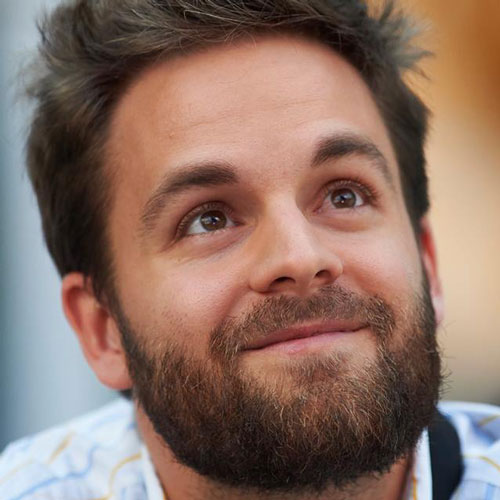
Joe Robinson has been working in the climbing industry for over a decade and currently manages CBJ editorial. He traveled the world as the IFSC’s community manager during Olympic inclusion and across the U.S. while writing for Alpinist, Climberism, DPM and CBJ. He also worked in local climbing gyms of the Pacific Northwest and West Michigan while advancing economic empowerment, educational equity, youth development and diversity programs of national nonprofit organizations.




